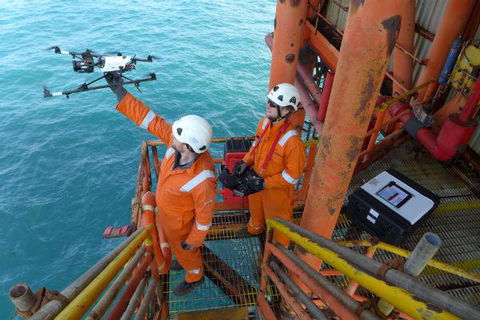Voltimum considers the benefits that UAV (or drone) technology could bring to electrical contracting businesses.

The increased use of drones over the last few years has been met with cynicism by some and wonder by other. Like many technologies, its merit is determined by those using it.
In the wrong hands, the presence of remote-controlled flying cameras is intrusive and the ability to carry payloads over walls and fences, a potential security risk in places like prisons, airports and government buildings.
However, in the right hands, there is are also obvious benefits. The emergency services can use drones to track criminals or fly out defibrillators to patients. The entertainment industries are using drones to collect exciting, dynamic footage. Soon there will even be entire fleets of drones delivering your online shopping. E-commerce giant, Amazon, is currently developing its Prime Air service. Once launched, Amazon will be able to deliver packages up to five pounds in 30 minutes or less using small UAVs.
Even restaurants are experimenting with the technology, As seen in the video below with Guzman y Gomez Burritos in Australia.
To find out more about the potential of UAV technology in electrical contracting, we decided to look at businesses that are already innovating in engineering and infrastructure sectors.
Drones in industry & construction
Formed in 2008, CyberHawk is one of the world’s leading engineering companies using UAVs for aerial inspection and surveying. Focused on industrial applications like on and offshore oil & gas facilities, wind farms and infrastructure, the Livingstone based company use drones and specialist software to collect data and present the findings to their clients so they can analyse and justify decisions.
Voltimum spoke with Philip Buchan, Commercial Director at CyberHawk. We asked Philip to summarise the advantages of using drones to inspect assets and collect data:
We see many benefits for using drones for data collection. Firstly, it’s safer. There’s less working at height. For someone to go and inspect something that is high up, live or difficult to access used to involve investing in scaffolding, the use of rope access and mobile elevated work platforms. Now people can stay safe on the ground and the drone can collect the vast majority of data instead.
Of course, the drones can’t fix and repair things but at least when people do have to go into potentially unsafe situations, they are doing so with a purpose. They already know what the problem is, they have seen the images, they have brought the right spare part. So, rather than having to set up scaffolding over a huge area, you can focus activity on the area where the drone has indicated there is a problem.
It’s also very efficient. A drone can collect data very quickly. It doesn’t require hours or days to set up. It just takes a matter of seconds for a drone to reach the problem area of a high-structure and you can immediately start collecting data. The time saved obviously translates into cost savings as well.
The efficiency and cost-saving are clear when looking at large industrial environments. But what about smaller construction sites and internal applications. Inspection and maintenance are part of an electrical contractor’s work set but often the installations in question are in confined, hard to reach areas, and faults can’t necessarily be identified via the standard stills and videos the drone collects.
“Our typical payloads are cameras or thermal imaging,” explains Phil. “The thermal imaging can reveal a lot of problems that regular images won’t identify,” he added.
“The drone technology keeps evolving. We are now using drones in internal and confined spaces. The drone is housed in a circular cage so it can bounce off surfaces and roll along walls without getting damaged. This has opened up the opportunity to use this equipment inside tanks, ducting and hard to access areas.”
As Philip asserts, Cyberhawk is not a maintenance operation. It quickly and efficiently provides people with the data needed to diagnose an issue so the problem can be solved as soon as possible. While electrical contractors won’t be inspecting overhead power lines or industrial chimney stacks, they will be checking up on external and warehouse lighting installations, for example. By using drones to collect the data beforehand, contractors can make informed, cost-efficient decisions about access equipment, tools and manpower so they can work smarter and safer.